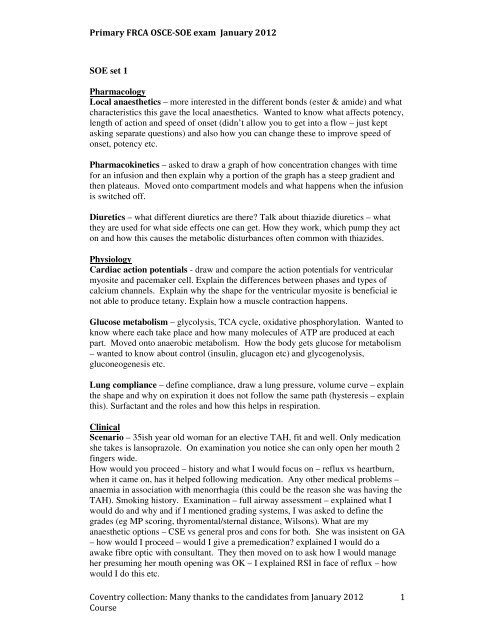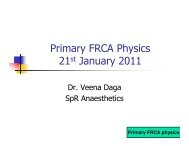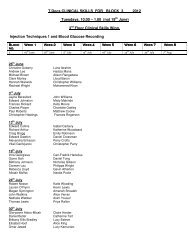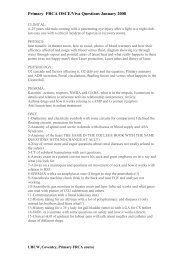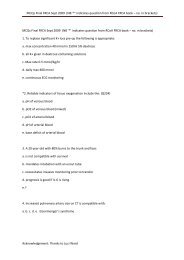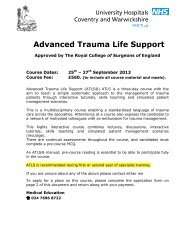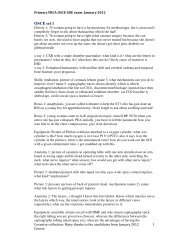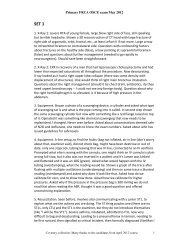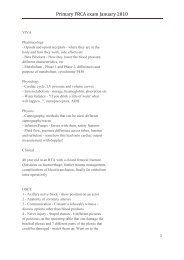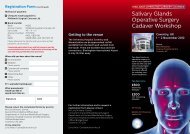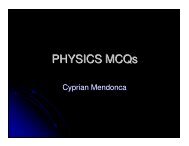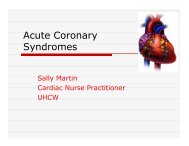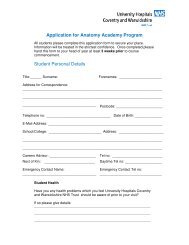Primary FRCA OSCE-SOE exam January 2012 Coventry collection ...
Primary FRCA OSCE-SOE exam January 2012 Coventry collection ...
Primary FRCA OSCE-SOE exam January 2012 Coventry collection ...
Create successful ePaper yourself
Turn your PDF publications into a flip-book with our unique Google optimized e-Paper software.
<strong>Primary</strong> <strong>FRCA</strong> <strong>OSCE</strong>-<strong>SOE</strong> <strong>exam</strong> <strong>January</strong> <strong>2012</strong><br />
<strong>SOE</strong> set 1<br />
Pharmacology<br />
Local anaesthetics – more interested in the different bonds (ester & amide) and what<br />
characteristics this gave the local anaesthetics. Wanted to know what affects potency,<br />
length of action and speed of onset (didn’t allow you to get into a flow – just kept<br />
asking separate questions) and also how you can change these to improve speed of<br />
onset, potency etc.<br />
Pharmacokinetics – asked to draw a graph of how concentration changes with time<br />
for an infusion and then explain why a portion of the graph has a steep gradient and<br />
then plateaus. Moved onto compartment models and what happens when the infusion<br />
is switched off.<br />
Diuretics – what different diuretics are there? Talk about thiazide diuretics – what<br />
they are used for what side effects one can get. How they work, which pump they act<br />
on and how this causes the metabolic disturbances often common with thiazides.<br />
Physiology<br />
Cardiac action potentials - draw and compare the action potentials for ventricular<br />
myosite and pacemaker cell. Explain the differences between phases and types of<br />
calcium channels. Explain why the shape for the ventricular myosite is beneficial ie<br />
not able to produce tetany. Explain how a muscle contraction happens.<br />
Glucose metabolism – glycolysis, TCA cycle, oxidative phosphorylation. Wanted to<br />
know where each take place and how many molecules of ATP are produced at each<br />
part. Moved onto anaerobic metabolism. How the body gets glucose for metabolism<br />
– wanted to know about control (insulin, glucagon etc) and glycogenolysis,<br />
gluconeogenesis etc.<br />
Lung compliance – define compliance, draw a lung pressure, volume curve – explain<br />
the shape and why on expiration it does not follow the same path (hysteresis – explain<br />
this). Surfactant and the roles and how this helps in respiration.<br />
Clinical<br />
Scenario – 35ish year old woman for an elective TAH, fit and well. Only medication<br />
she takes is lansoprazole. On <strong>exam</strong>ination you notice she can only open her mouth 2<br />
fingers wide.<br />
How would you proceed – history and what I would focus on – reflux vs heartburn,<br />
when it came on, has it helped following medication. Any other medical problems –<br />
anaemia in association with menorrhagia (this could be the reason she was having the<br />
TAH). Smoking history. Examination – full airway assessment – explained what I<br />
would do and why and if I mentioned grading systems, I was asked to define the<br />
grades (eg MP scoring, thyromental/sternal distance, Wilsons). What are my<br />
anaesthetic options – CSE vs general pros and cons for both. She was insistent on GA<br />
– how would I proceed – would I give a premedication? explained I would do a<br />
awake fibre optic with consultant. They then moved on to ask how I would manage<br />
her presuming her mouth opening was OK – I explained RSI in face of reflux – how<br />
would I do this etc.<br />
<strong>Coventry</strong> <strong>collection</strong>: Many thanks to the candidates from <strong>January</strong> <strong>2012</strong><br />
Course<br />
1
<strong>Primary</strong> <strong>FRCA</strong> <strong>OSCE</strong>-<strong>SOE</strong> <strong>exam</strong> <strong>January</strong> <strong>2012</strong><br />
Post op – on extubation, she developed laryngospasm; how would I manage this, how<br />
would I diagnose laryngospasm, who is more prone to it and what are the causes.<br />
Physics<br />
Humidity – why is it important in anaesthetics – prevent drying of gases, prevent heat<br />
loss, prevent static build up. Define absolute and relative humidity. How can you<br />
measure humidity – explain how they work.<br />
Pressure reducing valves – where are they found on an anaesthetic machine –<br />
cylinder to machine, Ritchie whistle. How they work – (the diagram was in front of<br />
you so you didn’t have to draw it) but an in depth explanation was needed.<br />
Force/energy – What is force? What is it measured in? Relationship to other derived<br />
SI units (I think they were getting onto force, pressure, area relationship). What is<br />
energy, different types of energy (electrical, mechanical (potential, kinetic), thermal).<br />
Explain about these and how you can change one form into another. Transducers<br />
were mentioned then I was asked how does a generator or a motor work – I think they<br />
were trying to get me to explain a bit more about how it can change one form of<br />
energy into another.<br />
<strong>SOE</strong> set 2<br />
Pharmacology viva<br />
- Differences between Fentanyl and Alfentanil; lipid solubility, pKa, Ionisation,<br />
dose/potency hence concentration gradient, volume of distribution and clearance<br />
Gastric acid secretion; drugs that work on that, PPIs, H2 antagonists, Antimuscarinics,<br />
moved on to antiemetics, prokinetics<br />
- Population variability in drug metabolism: I started off by talking about where drugs<br />
are metabolised (liver, kidneys, lung, plasma, gut) and pharmacokinetics. I said that<br />
what the body does to the drug (pharmacokinetics) can be split into Absorbtion,<br />
Distribution, Metabolism, Excretion and then went on to discuss each factor<br />
mentioning the following: genetic variability (Ea:Ea Dibucaine, acetylation, phase 1<br />
and phase 2 metabolism), lifestyle factors such as smoking and alcohol, physiological<br />
factors such as old age, neonates, pregnancy and pathological factors such as sepsis,<br />
renal failure, coealiacs, ileus, liver failure.<br />
Physiology<br />
- Oxygen- Hb dissociation curve; p50, what makes it go left and right, what is 2-<br />
3DPG, why is it sigmoid, Bohr shift, Haldane effect, Hamburger effect<br />
-How is CO2 stored in the body? Bicarb, carbamino compounds, dissolved<br />
- Left ventricular pressure trace and draw the aortic pressure trace. How does the<br />
aortic pressure trace change with aortic stenosis? how can you work out the mean<br />
arterial pressure from the trace?<br />
<strong>Coventry</strong> <strong>collection</strong>: Many thanks to the candidates from <strong>January</strong> <strong>2012</strong><br />
Course<br />
2
<strong>Primary</strong> <strong>FRCA</strong> <strong>OSCE</strong>-<strong>SOE</strong> <strong>exam</strong> <strong>January</strong> <strong>2012</strong><br />
Clinical:<br />
71 year old female booked to have an emergency laparotomy for acute cholecystitis.<br />
She is jaundiced and she has abdominal pain. The surgeons say she is septic and they<br />
suspect that she has a perforated viscus.<br />
This question threw a lot of people after the <strong>exam</strong> as it was very medicine orientated<br />
and less anaesthetics, so I kept calm and went back to medical school basics.<br />
-What are the causes of jaundice? I defined that jaundice was due to an increase of<br />
bilirubin in the plasma and it is a breakdown product of red blood cells and normally<br />
broken down in the spleen. Causes can be pre-hepatic, hepatic, post-hepatic.<br />
the <strong>exam</strong>iner asked for <strong>exam</strong>ples of each: pre hepatic; haemolytic causes such as<br />
sepsis or thalasaemia and sickle cell, hepatic; liver disease, cirhosis, hepatitis,<br />
autoimmune, infective or drug related. post hepatic; obstrucion<br />
- How would you assess this patient and what is your plan? they particularly probed<br />
as to how I would assess her fluid balance status and I eventually got that they wanted<br />
me to say that I would out in invasive monitoring such as CVC line and NIBP and<br />
take her to HDU for pre-optimisation...I did not expect that they would want me to<br />
say that because in real life most hospitals don't have this facility. I mentioned I<br />
would assess her for an epidural but the stern response I got from the <strong>exam</strong>iners,<br />
"would you put in an epidural in this woman?" I promptly said no because she was<br />
septic<br />
- She suddenly becomes hypotensive in theatre; what are your differentials and how<br />
would you treat? (ABC, call for help, top differentials; anaesthetic, patient or surgical<br />
causes)<br />
- post op care? analgesia, ITU/HDU, intubated or extubated?<br />
Physics<br />
Vaporisers<br />
- what are the features of an ideal vaporiser? high heat capacity, high thermal<br />
conductivity<br />
why? so it can retain a lot of heat and then give it easily to the inhalational agent to<br />
vaporise it, talked about latent heat, SVP<br />
- talked about draw over vs Plenum and how a plenum vaporiser works? how and why<br />
do they need temperature compensation? talked about the bimetallic strip and that<br />
SVP is only dependent on temperature hence the need for compensation<br />
-talk through desflurane vaporiser and the differences.<br />
How can you give an infusion of a drug?<br />
- volumetric pump, syringe driver, by hand, drip counter...he asked me anything<br />
else...I didn't know there was anything else<br />
- showed me a picture of an alaris syringe driver and asked me for sources of error<br />
with this: pump factors (servicing, power failure, microshock), programming factors<br />
(wrong inputted data, wrong programme, no labelling) and patient end (occlusion,<br />
wrong kind of connecting infusion sets, no anti siphon no anti reflux, disconnection).<br />
- He then showed me another set of pictures: one was a tci connection tubing that was<br />
yellow (used for epidural infusions too), one was for PCA connections, one was the y-<br />
connector tubing we had in the coventry course osce with the two anti reflux valves<br />
<strong>Coventry</strong> <strong>collection</strong>: Many thanks to the candidates from <strong>January</strong> <strong>2012</strong><br />
Course<br />
3
<strong>Primary</strong> <strong>FRCA</strong> <strong>OSCE</strong>-<strong>SOE</strong> <strong>exam</strong> <strong>January</strong> <strong>2012</strong><br />
and he asked me to explain the anti reflux and anti siphon mechanisms and what is<br />
connected to what.<br />
<strong>SOE</strong> set 3<br />
Physics:<br />
Laryngoscopes ,shape of layringoscope,<br />
BPmeasurement , how do u measure bp of patient in ward, why 4th kororkoff.<br />
Clinical:<br />
45 yr old obese , problems during anaesthesia , preassesment, wt is obesity, prone<br />
position and precautions ? Reflux<br />
How do u anaesthetise and wt drug doses are used, sensitivity to morphine etc<br />
In recovery desaturating : wt do u do<br />
Physio<br />
Hypoxia , types, odc, Wts. Venous point , wt happens in different types of hypoxia to<br />
venous point.<br />
Na and it's regulation<br />
Osmolality and regulation<br />
Draw nephron and show na in it<br />
Pharmacology:<br />
iv anaesthetic agents. Class , draw thio , propofol,, difference b/n them and thio in<br />
detail, y sulphur.<br />
Dose response curves , log dose etc<br />
Colloids and differences between each<br />
<strong>SOE</strong> set 4<br />
Pharmac<br />
IV induction agents particularly barbiturate structure<br />
Dose response, affinity, potency, efficacy<br />
Colloids, diff between starches and gelatins, properties of ideal colloid<br />
Physiology<br />
Sodium handling<br />
Hypoxia, affects on o2 diss curve.<br />
Capillaries<br />
Clinical<br />
Obese man with OSA for pilonidal sinus. Post op hypoxia<br />
Physics<br />
Laryngoscopes<br />
Osmolality and osmolometer<br />
Bp measurement, only interested in nibp.<br />
<strong>Coventry</strong> <strong>collection</strong>: Many thanks to the candidates from <strong>January</strong> <strong>2012</strong><br />
Course<br />
4
<strong>Primary</strong> <strong>FRCA</strong> <strong>OSCE</strong>-<strong>SOE</strong> <strong>exam</strong> <strong>January</strong> <strong>2012</strong><br />
<strong>SOE</strong> set 5<br />
Pharmacology<br />
Structure and classification of iv induction agents – propofol, thio, ketamine,<br />
etomidate. Classes of barbiturates inc methohexitone. What is in each vial of iv<br />
induction agent<br />
2.Dose response curve, ED50, full agonist graph, efficacy, affinity, and partial agonist<br />
graph.<br />
3.Compare and contrast HES with gelatins<br />
Physiology<br />
Describe starlings forces in capillaries, specifically in pulmonary capillaries, draw<br />
graph of art vs venous in lungs. Compare with systemic<br />
Describe Na control in body. Causes of hyponatraemia, symptoms<br />
Hypoxia. Oxy Hb curve, changes in histotoxic, stagnant hypoxia. Mixed venous vs o2<br />
content<br />
Physics<br />
BP measurement. Korotkoff sounds, manometer, dinamap<br />
Compare and contrast different laryngoscopes<br />
Osmolarity vs osmolality. Calculation of, colligative properties. Ion gap, equation,<br />
causes of increased<br />
Clinical: Patient listed for pilonidal sinus<br />
<strong>SOE</strong> set 6<br />
Physio SoE -<br />
1. Glucose metabolism - control . Pathways - what it produce.<br />
2. AP - pace maker , ventricle - details<br />
3 Compliance - what is hysteresis , etc<br />
Pharmac -<br />
1. LA - compare lignocaine , bupicaine , onset , max dose details<br />
2. Diuretics - classification , details of bendro .<br />
3. Washin curve - Iv infusion , compartment model , LD , MD - calculations why ? ,<br />
how .<br />
Physics -<br />
1.press regulating valve - draw , explain<br />
2. Force , Newton , energy - in details .<br />
3. humidity - everything .<br />
<strong>Coventry</strong> <strong>collection</strong>: Many thanks to the candidates from <strong>January</strong> <strong>2012</strong><br />
Course<br />
5
<strong>Primary</strong> <strong>FRCA</strong> <strong>OSCE</strong>-<strong>SOE</strong> <strong>exam</strong> <strong>January</strong> <strong>2012</strong><br />
<strong>SOE</strong> set 7<br />
Physiology:<br />
1. Cerebral blood flow - factors affecting ICP, Monro-Kellie doctrine, curves for CBF<br />
vs PaO2 & PaCO2, autoregulation & associated theories.<br />
2. Thyroid - hormones produced, feedback mechanism, functions of hormones,<br />
calcitonin & Ca2+ homeostasis<br />
3. Showed picture of alveolus with adjacent pulmonary capillary. Asked to write<br />
down alveolar partial pressures of CO2 & O2, then mixed venous pressures. What<br />
happens during apnoea - changes in numbers. What happens if alveolus closed off,<br />
what happens if alveolus left open to air? How can you increase the time of to<br />
hypoxia during apnoea (essentially asking re. pre-oxygenation). What factors cause a<br />
shorter time to hypoxia in apnoea (reduced FRC, increased O2 consumption, etc).<br />
How can you manipulate this in anaesthetics?<br />
Pharmacology :<br />
1. Drugs that reverse NMB (anti-cholinesterases, Sugammadex). Classify. How do<br />
they work? What are the SEs (muscarinic effects). How do we overcome this<br />
(glycopyrrolate etc). Tell me more about Sugammadex, how does it work, can I use it<br />
with vecuronium? What about atracurium? Why?<br />
2. What is volume of distribution? How can it be measured. Draw concentration vs<br />
time graph. What else can be derived from graph (t1/2, time constant)? What is<br />
bioavailability? Demonstrate on graph how you can measure it (AUC).<br />
3. Anti-emetics. Draw diagram of VC, CTZ and receptors involved. Tell me more<br />
about different drugs on different receptors, effects. Indicate on diagram where<br />
d<strong>exam</strong>ethasone acts.<br />
Physics<br />
1. Peripheral nerve stimulator - components, supramaximal stimulus, which nerves<br />
can you use, which site is most accurate, ToF (various <strong>exam</strong>ples given, difference in<br />
patterns between non-depol & sux), what frequency & amplitude would you use.<br />
2. Arterial tourniquet. Uses, components, max pressure used, max time allowed &<br />
why. What if surgeon needs to keep tourniquet on for longer, what would you do?<br />
Physiological changes during inflation & after deflation.<br />
3. Given various equations and asked to draw curve. (y = mx + c, xy = constant).<br />
When do we see these graphs in our anaesthetic practice? Shown various graphs and<br />
asked to write equations for them.<br />
Clinical scenario<br />
19 year old boy brought into emergency department after falling down stairs outside<br />
nightclub. He is confused & agitated.<br />
Differential diagnoses, effects of alcohol & drugs on conscious level & diagnosis.<br />
What investigations? He requires a CT - how would you manage? Cushing's reflex -<br />
how would you treat. How do you reduce secondary brain injury. He now needs a<br />
transfer to neurosurgical unit - how would you manage this.<br />
<strong>Coventry</strong> <strong>collection</strong>: Many thanks to the candidates from <strong>January</strong> <strong>2012</strong><br />
Course<br />
6
<strong>Primary</strong> <strong>FRCA</strong> <strong>OSCE</strong>-<strong>SOE</strong> <strong>exam</strong> <strong>January</strong> <strong>2012</strong><br />
<strong>SOE</strong> set 8<br />
LA and onset factors<br />
Henderson Hasselbach<br />
La toxicity<br />
Routes of admin drugs<br />
Focus on first pass metabolism<br />
Bioavailability and factors affecting it<br />
Gabapentin what do you know<br />
Antiepileptics site of action<br />
Pacemaker cells<br />
Action potential for myocyte vs pacemaker<br />
Symp effect<br />
Water compartments<br />
Effect of dextrose vs saline<br />
Osmoreceptors<br />
Vent perfusion lung graph<br />
West zones<br />
Effect of exercise<br />
Effect on PVR<br />
Clinical 75 obese strangulated hernia. On metformin and smoker.<br />
Decreased conscious level in recovery. Differential and mx<br />
Ways to measure flow<br />
Hot wire pnemotachograph in detail<br />
Rotameters<br />
Doppler principle<br />
Doppler equation<br />
Ways to measure cardiac output<br />
Lidco<br />
<strong>SOE</strong> set 9<br />
Physiology<br />
1. Glucose metabolism - control . Pathways - what it produce.<br />
2. AP - pace maker , ventricle - details<br />
3 Compliance - what is hysteresis , etc<br />
Pharmacology -<br />
1. LA - compare lignocaine , bupicaine , onset , max dose details<br />
2. Diuretics - classification, details of bendrofluazide.<br />
3. Washin curve - IV infusion , compartment model , LD , MD - calculations why ? ,<br />
how .<br />
<strong>Coventry</strong> <strong>collection</strong>: Many thanks to the candidates from <strong>January</strong> <strong>2012</strong><br />
Course<br />
7
<strong>Primary</strong> <strong>FRCA</strong> <strong>OSCE</strong>-<strong>SOE</strong> <strong>exam</strong> <strong>January</strong> <strong>2012</strong><br />
Physics -<br />
1.press regulating valve - draw , explain<br />
2. Force , Newton , energy - in details .<br />
3. humidity - everything .<br />
<strong>SOE</strong> set 10<br />
Pharmacology:<br />
1) Pharmacokinetics: Absorption, Distribution (define Vd, give equations),<br />
Metabolism, Excretion. Draw a curve of plasma concentration of iv drug against time<br />
following bolus administration (one-compartment model). Write equation for this<br />
graph. How could you make analysis of this graph better? (semi-log). Please draw this<br />
new graph. What parameters can you derive from this graph. Tell me about<br />
bioavailability. What is time constant, half-life, relationship of one to the other.<br />
2) Anticholinesterases: Started off with 'what drug would you use to reverse<br />
neuromuscular blockade'. Then went on to details about each drug ie neostigmine,<br />
pyridostigmine, physotigmine, edrophonium, organophosphates & how they bind to<br />
the cholinesterase enz. Which used to treat myasthenia gravis. Sugammadex asked at<br />
the end.<br />
3) Receptors involved in vomiting: where centrally & peripherally. Different types of<br />
anti-emetics, and where they act, side effects. Why is metoclopramide not very<br />
effective. Why is chlorpromazine not used as anti-emetic.<br />
Physiology<br />
1) Cerebral blood flow. What maintains CBF. Monro-Kellie hypothesis. Volume of<br />
different compartments of skull (ie brain, CSF, blood). Different graphs showing<br />
effects of differing po2, pC02 on CBF. Mechanisms of autoregulation.<br />
2) Oxygen cascade. Photo of alveolus & pulmonary capillary - indicate the partial<br />
pressures of o2 & co2 at different sites. Hypoxic Pulmonary Vasoconstriction.<br />
3) Thyroid gland. Synthesis of thyroid hormones. Transport and MOA of T4/T3.<br />
Effects on body. Feedback mechanisms. Calcitonin & Ca metabolism.<br />
Physics<br />
1) Peripheral Nerve Stimulator. Where would you place PNS to monitor<br />
neuromuscular blockade? Why is ulnar crease better than facial nerve? (avoid direct<br />
muscle stimulation). TOF, DBS, Tetanic, PTC. Mechanism of fade. TOF ratio.<br />
2) Arterial Tourniquets: indications, components, contraindications, complications.<br />
3) Graphs: shown various graphs and asked to write the equations for each. Also<br />
asked to give clinical <strong>exam</strong>ples of each graph. (ie negative exponential, positive<br />
exponential, straight-line, rectangular hyperbolic)<br />
Clinical<br />
19yo male fell down stairs at nightclub at 2am. Brought into AE confused & agitated.<br />
Differential diagnoses, how manage, when would you intubate, etc. Straightforward.<br />
<strong>Coventry</strong> <strong>collection</strong>: Many thanks to the candidates from <strong>January</strong> <strong>2012</strong><br />
Course<br />
8
<strong>Primary</strong> <strong>FRCA</strong> <strong>OSCE</strong>-<strong>SOE</strong> <strong>exam</strong> <strong>January</strong> <strong>2012</strong><br />
<strong>SOE</strong> set11<br />
Pharmacology:<br />
1. Inhalational agents<br />
a) Which agents you normally use<br />
b) Compare and contrast Sevo, Des and Iso<br />
c) Draw Fa/Fi curve and talk through it<br />
2. Intrathecal and epidural drugs<br />
a) Routes of drug administration<br />
b) Name some drugs that can be given intrathecally and epidurally<br />
c) Ideal properties of an agent for these routes.<br />
d) What type of drugs cannot be used<br />
3. Oral hypoglycaemic drugs<br />
a) Name all 5 classes<br />
b) Mechanism of action of all<br />
c) Pharmacokinetics and side effects of all<br />
Physiology<br />
1) Pacemaker and Myocardial muscle Action Potential<br />
a) Where are the pacemakers situated in heart<br />
b) Draw AP for a pacemaker cell and talk through all the phases<br />
c) Draw AP for Myocardial muscle, compare and contrast with pacemaker cell<br />
2) Buffer (same as the college question)<br />
a) Define, properties of an ideal buffer<br />
b) physiological buffers of body<br />
c) importance of each<br />
d) how much acid produced daily?<br />
3) If you accidentally put your leg on a pin , what happens<br />
Asked about pain pathways, withdrawal reflex and knee jerk<br />
Clinical:<br />
1) Non progress of labour in a term gravida with epidural for labour analgesia, posted<br />
for caserean section. How will you evaluate this patient and proceed.<br />
2) Lady has been managed with epidural for C Section. If after baby delivery<br />
develops pain, how will you manage<br />
3) PDPH: detailed discussion of epidural patch.<br />
Physics:<br />
1) Temperature measurement:<br />
a) Shown a photo which had oesophageal probe, infrared thermometer and mercury<br />
thermometer. Identify<br />
b) Principles, advantages and disadvantages of each<br />
<strong>Coventry</strong> <strong>collection</strong>: Many thanks to the candidates from <strong>January</strong> <strong>2012</strong><br />
Course<br />
9
<strong>Primary</strong> <strong>FRCA</strong> <strong>OSCE</strong>-<strong>SOE</strong> <strong>exam</strong> <strong>January</strong> <strong>2012</strong><br />
c) Methods of temperature measurement. Detailed discussion on electrical methods<br />
with drawing and discusiion of graphs.<br />
2) Pressure<br />
a) Define and units<br />
b) Application in clinical practice<br />
c) Shown a picture of pressure regulator and asked about its principle (weird picture)<br />
3) Fibreoptic:<br />
a) parts, difference between fibreoptic laryngoscope and fibreoptic broncoscope<br />
b) uses, principle of working , advantage over traditional laryngoscope<br />
c) cleaning and sterilisation<br />
<strong>SOE</strong> set 13<br />
Pharmacology<br />
- opening q: 'what drugs can we give intravenously?' - not a q i had prepared for, but<br />
started by saying i could classify, then first mentioned iv induction agents, at which<br />
point he stopped me and took me entirely down that route. all the structures and how<br />
they relate to the drug characteristics<br />
- colloids/ ideal colloid<br />
- dose-response curves and shifts<br />
Physiology<br />
- sodium handling in the body (very specific)<br />
- hypoxia, curves<br />
- fluid movement across capillaries - gradients.<br />
This felt like my worst viva, sometimes felt like a tutorial!<br />
clinical<br />
- morbidly obese man for pilonidal sinus and flap repair - all the issues<br />
Physics:<br />
- laryngoscopes - design, features<br />
- osmolarity, osmometer, definitions<br />
- can't remember sorry.<br />
<strong>SOE</strong> set 14<br />
Pharmacology<br />
Discuss why you would use sevo or desflurane as alternative to isoflurane.<br />
Routes of administration of drugs- discussion into intrathecal and why we would<br />
administer drugs in this way (pharmacokinetics, mechanism of action)<br />
Type II diabetes mellitus drugs- wanted detail description of how peripheral<br />
sensitization to insulin occurred.<br />
Physiology<br />
Reflex arcs, pain pathways<br />
<strong>Coventry</strong> <strong>collection</strong>: Many thanks to the candidates from <strong>January</strong> <strong>2012</strong><br />
Course<br />
10
<strong>Primary</strong> <strong>FRCA</strong> <strong>OSCE</strong>-<strong>SOE</strong> <strong>exam</strong> <strong>January</strong> <strong>2012</strong><br />
Buffers- draw buffer titration curve, different types of buffers. Open/ closed. Gibbs<br />
Donnan equation<br />
Cardiac nerve conduction comparing pacemaker and myocyte. How SNS and PNS<br />
would effect it.<br />
Physics<br />
Temperature measurement. Details of transcutaneous measurement and oesophageal.<br />
Pressure- balloon inflated under water, how will pressures and volumes change.<br />
Adding nano newtons to milli newtons, discussion of integers.<br />
Fibreoptic scope. Draw cross section of it. How to use it and clean it. Total internal<br />
reflection.<br />
Clinical<br />
Epidural for labour in primigravida. Needs to go to theatre for failure to progress.<br />
What would you do?<br />
Categories of section. Pain intraoperatively.<br />
PDPH- differential dx, treatment.<br />
<strong>SOE</strong> set 15<br />
Pharmacology<br />
1. Opioid receptors, partial agonists, side effects of opioids<br />
2. Concentration – time curves for IV bolus, infusion, infusion of alcohol(!). VD<br />
and Clearance.<br />
3. Inotropes and inodilators.<br />
Physiology<br />
1. Baroreceptor response<br />
2. Functions of the placenta<br />
3. Lung volumes, FRC, closing capacity<br />
Clinical<br />
1. 42 year old with dental abscess, limited mouth opening, asthma<br />
2. Critical incident – laryngospasm on extubation<br />
3. Dental anaesthesia, conscious sedation<br />
Physics<br />
1. Cylinders inc. how to attach to anaesthetic machine<br />
2. Cardiac output measurement. Doppler effect, Swan Ganz catheter –<br />
complications<br />
<strong>SOE</strong> set 16<br />
Pharmacology<br />
- Isoflurane vs Sevoflurane<br />
- Pharmacogenetics<br />
- Digoxin<br />
Physiology<br />
- Vomiting<br />
- Cardiology: formation of the BP trace, and PV relationships<br />
<strong>Coventry</strong> <strong>collection</strong>: Many thanks to the candidates from <strong>January</strong> <strong>2012</strong><br />
Course<br />
11
<strong>Primary</strong> <strong>FRCA</strong> <strong>OSCE</strong>-<strong>SOE</strong> <strong>exam</strong> <strong>January</strong> <strong>2012</strong><br />
- Buffers<br />
Clinical<br />
- Emergency laparotomy of 65 yo male, previous PE 6/12 ago (warfarinised), but<br />
otherwise fit and well.<br />
- INR now 5.8, ARF<br />
- Describe your immediate concerns<br />
- How would you proceed?<br />
- Discussion of pre-, peri-, post-operative management<br />
Physics & Measurement<br />
- Electrical Safety<br />
- Transducers<br />
- Scavenging<br />
<strong>SOE</strong> set 17<br />
Pharmacology<br />
Propofol ,thio<br />
Statistics,type of errors,null hypothesis,formulas of errors,methods to minimise.<br />
Drugs for asthama,mechanism,leukotrienes inhibitors,aminophylline.<br />
Physiology<br />
Role of heart, why four chambers,role of atria,work done,why venous side not<br />
pulsatile.frank starling curves.<br />
Foetal circulation explain with diagram,oxygen%,what happens with first breath.how<br />
and why foraman ovale and ductus close.<br />
Clinical,<br />
12 yr boy 65 kg,for post trauma,fall fro swing,for radius MIA,SOS playing past<br />
history of excema and penicillin allergy.<br />
All pediatric questions,critical incident,laryngospasm,aspiration and management.<br />
Physics<br />
Methods for blood warming,design your own device.<br />
Fibreoptic,working and principles<br />
Light measurment,definition,pulse ox.beer lamberts law.other methods where light<br />
principles are used<br />
Differential amplifier.<br />
Biological potentials.how are these measured,why different.<br />
<strong>SOE</strong> set 18<br />
Pharmacology<br />
1) The <strong>exam</strong>iner began by asking for 3 clinical effects of Ketamine, which I gave her,<br />
but then when she went on to ask for more details about the pharmacology of<br />
ketamine, I drew blanks, I honestly did not revise this to sufficient detail that the<br />
answers took a while to come out with. Particularly, she had to prompt me about the<br />
receptors it acted on, and the side effects, and I couldn't answer the question fluently.<br />
2) Name me the different types of receptors. This was a much better question and I<br />
managed to show and draw the 4 different receptor types.<br />
<strong>Coventry</strong> <strong>collection</strong>: Many thanks to the candidates from <strong>January</strong> <strong>2012</strong><br />
Course<br />
12
<strong>Primary</strong> <strong>FRCA</strong> <strong>OSCE</strong>-<strong>SOE</strong> <strong>exam</strong> <strong>January</strong> <strong>2012</strong><br />
3) Classify anti-angina drugs. Again I was let down by my lack of knowledge. I could<br />
only recall Nitrates, and tried to steer the discussion towards antihypertensives and<br />
heart failure medications, but she was having none of it.<br />
Physiology<br />
1) The <strong>exam</strong>iner asked me what contributes to resting membrane potential in nerve<br />
cells. I wanted to write out the Nernst equation but he didn't want me to use that to<br />
explain it. Then I said the Goldman Field equation, but again he didn't want me to<br />
reproduce that. In the end he seemed rather annoyed and I offered the answer of intra<br />
and extra cellular concentrations of ions. He then asked why the concentrations were<br />
different and I said it was the Na/K ATPase pump, but he said why then does the<br />
potassium ion contribute more to the membrane potential. I realised after a while that<br />
he wanted me to say the Gibbs Donnan effect. But by this point the<br />
miscommunication caused alot of time to be wasted. He asked me to draw an action<br />
potential and explain how it worked, which I reproduced. All in all, quite frustrating<br />
that we seemed not to be meeting across the table<br />
2) He asked what Basal metabolic rate was, which I didn't have a good definition for,<br />
and I offered something to the effect of basal oxygen requirements and the amount of<br />
work done by the body to maintain homeostasis. Unprepared for this question and it<br />
was quite painful<br />
3) He asked what happens when we breathe in 100% oxygen in the alveolus, and<br />
wrote out the Alveolar oxygen equation. Thought that this question wasn't too bad, at<br />
least I could use the equation to answer his hypothetical scenarios. He asked what<br />
happens at altitude and what happens at high bariatric pressures.<br />
Clinical<br />
Patient 28 yrs old with Diabetes for appendicectomy. Temperature of 38 degrees and<br />
BM of 28.<br />
I thought this question went quite well, and was confident about my answers<br />
Physics<br />
1) Asked what was alveolar dead space, which I responded by saying it parts of the<br />
airway which is ventilated but not perfused. Then asked how we measure anatomical<br />
deadspace, which I responded with Fowler's method and drew the graph and<br />
explained it. Then he asked how we measure physiological deadspace, which I used<br />
the Bohr equation to answer. but he tried to trick me by saying isn't Vt tidal volume<br />
and not total lung volume. Asked me to show how to derive it, it started to derive it by<br />
drawing out the lung and labelling Vt and Vd and Vt-Vd, but when he confused me<br />
with tidal volume versus total lung volume, I apologised and said I couldn't derive it<br />
there and then.<br />
2) Showed me a piece of paper with a number of different electrical symbols and<br />
asked what some of them were, which I answered. Then asked what devices we can<br />
find capacitors in, I used the defib as an <strong>exam</strong>ple. Asked me to draw the circuit, which<br />
I did, then asked me what the inductor in the circuit was for, and I drew the 2 current<br />
versus time curves and explained the inductor slows the discharge of the energy.<br />
3) Asked me what a vacuum was, and asked where we might have vacuums in<br />
anaesthetic practice, I answered scavenging and suction. He asked me about active<br />
scavenging.<br />
<strong>Coventry</strong> <strong>collection</strong>: Many thanks to the candidates from <strong>January</strong> <strong>2012</strong><br />
Course<br />
13
<strong>Primary</strong> <strong>FRCA</strong> <strong>OSCE</strong>-<strong>SOE</strong> <strong>exam</strong> <strong>January</strong> <strong>2012</strong><br />
<strong>SOE</strong> set 19<br />
Physics 1. fluid warming system types inc level one 2. light waves and mechanism of<br />
fibreoptics. 3. Electrode potentials eg EEG, differences and how they work<br />
Clinical: 12 y o boy who mum says fell from a swing 15 hours ago. Penicillin allergy.<br />
Closed # radius for MUA+-.. How would you assess? How would you do the<br />
anaesthetic? Incident: laryngospasm under LMA and how to manage / differential<br />
Pharm: 1. Propofol including pharmacokinetics. 2. Type I and II errors, sample sizes,<br />
bias. 3. Drugs for asthma and mechanisms<br />
Physiology: 1. Fetal circulation. 2. Curves for CO2 versus MV in both awake and<br />
ventilated patients (ie reciprocal axes). 3. Functions of the heart; CO determinants;<br />
what happens if the atria were removed?<br />
<strong>SOE</strong> set 20<br />
Pharmacology<br />
- Isoflurane vs Sevoflurane<br />
- Pharmacogenetics<br />
- Digoxin<br />
Physiology<br />
- Vomiting<br />
- Cardiology: formation of the BP trace, and PV relationships<br />
- Buffers<br />
Clinical<br />
- Emergency laparotomy of 65 yo male, previous PE 6/12 ago (warfarinised), but<br />
otherwise fit and well.<br />
- INR now 5.8, ARF<br />
- Describe your immediate concerns<br />
- How would you proceed?<br />
- Discussion of pre-, peri-, post-operative management<br />
Physics & Measurement<br />
- Electrical Safety<br />
- Transducers<br />
- Scavenging<br />
<strong>SOE</strong> set 21<br />
Physiology<br />
1) Heat loss and control: Where is heat regulation controlled in body. What happens<br />
when you are too hot and what happens when you are too cold? What does a dog<br />
do?!<br />
2) Cardiac pressure vs time curve: Left ventricle, aorta and ECG on it. What is<br />
isovolumetric contraction. Starlings Law.<br />
<strong>Coventry</strong> <strong>collection</strong>: Many thanks to the candidates from <strong>January</strong> <strong>2012</strong><br />
Course<br />
14
<strong>Primary</strong> <strong>FRCA</strong> <strong>OSCE</strong>-<strong>SOE</strong> <strong>exam</strong> <strong>January</strong> <strong>2012</strong><br />
Pharmacology<br />
1) How does paracetamol work? Where are it’s receptors and what are they? How<br />
can it be administered? What happens in overdose? How do we treat overdose.<br />
Are there any other harmful effects of paracetamol? Because I mentioned COX at<br />
some point in my answer, they also asked me to draw the arachadonic acid-<br />
PG/leucotriene flow diagram to show what COX does. Briefly at the end I was<br />
asked what side effects NSAIDS have that parsacetamol don’t.<br />
2) This question was sort of about context-sensitive half lives I think, but I didn’t<br />
really understand it. It was to do with what happened when you stopped an<br />
infusion that had been maintaining steady state and to draw a concentration time<br />
graph for fentanyl after stopping the infusion which had been going for 8 hours<br />
and to draw the same thing but for after a fentanyl infusion that lasted 20mins.<br />
Also something about half life.<br />
3) Heparin- mode of action. Different types. What are the molecular weights? What<br />
kind of chemical is it. Is there any heparin in our body? Where is it?<br />
Clinical<br />
Man, 78, for TURP. States he may have had a small MI 6 months ago and had<br />
some tests done. Now on clopidogrel and aspirin. Also, has a blood pressure of<br />
190/105.<br />
- What are the main anaesthetic concerns.<br />
- How long might someone need to be on clopidogrel after a stent is inserted?<br />
- How could I find out if he had had an MI (They wanted an immediate test that<br />
might help- turned out they wanted ECG)<br />
- What are anaesthetic options?<br />
- Postpone?<br />
- How long to wait after stopping clopidogrel before doing a spinal? Why might<br />
people having this op bleed a lot if they are on anti-coagulants?<br />
- Assuming it has been postponed and he comes back off clopidogrel and BP is<br />
controlled, what anaesthetic will I do?<br />
- Absolute contraindications to spinal<br />
- Patient becomes SOB and agitated: Diff diagnosis<br />
- Treatment of TURP syndrome. Investigations that can be done to confirm it.<br />
- Patient worsens becomes even more hypoxic- management now? Where to<br />
send after theatre?<br />
<strong>Coventry</strong> <strong>collection</strong>: Many thanks to the candidates from <strong>January</strong> <strong>2012</strong><br />
Course<br />
15
<strong>Primary</strong> <strong>FRCA</strong> <strong>OSCE</strong>-<strong>SOE</strong> <strong>exam</strong> <strong>January</strong> <strong>2012</strong><br />
Physics<br />
1) Ventilator: What are the ideal properties of a ventilator for transport? This<br />
question was all very vague and I had a lot of trouble answering this one. There<br />
was a lot about what modes I might want. How much Oxygen would I need for<br />
the trip: What factors would I need to know before setting off to work this out?<br />
How would I work out how much to take?<br />
2) A picture of N2O Isotherms- asked to explain each one. Define SHC, SLH of<br />
Vaporisation, SLH of fusion. Define BP and freezing point. How do these change<br />
up a mountain? What is the SHC of water?<br />
3) Draw a CO2 electrode. How does it work? How is it calibrated? What is the<br />
relationship between pCO2 and voltage?<br />
<strong>SOE</strong> set 22<br />
Pharmacology<br />
1: “Tell me about vecuronium”<br />
Turned into a comparison with rocuronium, focused on pharmacokinetics especially<br />
onset speed. Moved into reversal methods. Also discussed antagonism and agonism.<br />
2: “Draw on concentration-time curve for a single compartment model”<br />
Discussed time constant, half life, exponential function, then moved to two<br />
compartment model including equation of it and what could be derived from the<br />
graph (A, B, compartmental time constants0.<br />
3. “How do anti-epileptics work?”<br />
Classify, how and where (on a cellular level) do they work. Any other<br />
receptors that could be used, started to discuss calcium involvement in nervous<br />
transmission and potential as a target. Wanted to know any calcium channel blockers<br />
used in epilepsy.<br />
Physiology<br />
1: “What happens if some one breathes 100% oxygen for 5 minutes”<br />
Led to discussion and manipulation of alveolar gas equation and oxygent<br />
content equation. Then oxyhaemoglobin dissociation curve. What happens to this<br />
curve in hyperbaric oxygen?<br />
2: “Tell me about the pituitary”<br />
Where is it. Hormones produced and how. How controlled. Where exactly is<br />
the portal system? What does ADH do? Are renal and peripheral ADH receptors the<br />
same?<br />
3: “How does a nerve impulse cause movement?”<br />
<strong>Coventry</strong> <strong>collection</strong>: Many thanks to the candidates from <strong>January</strong> <strong>2012</strong><br />
Course<br />
16
<strong>Primary</strong> <strong>FRCA</strong> <strong>OSCE</strong>-<strong>SOE</strong> <strong>exam</strong> <strong>January</strong> <strong>2012</strong><br />
Excitation-contraction coupling. Draw a sarcomere. Where are the t-tubules,<br />
where is the calcium. What does calcium do? Compare skeletal muscle to cardiac,<br />
including drawing action potentials.<br />
Clinical<br />
83 male, bowel perf, septic, ARF/CRF, hr 120 irregular.<br />
1: Issues and anaesthetic mangement.<br />
2: Hypotension interop.<br />
3: Post op care. Included analgesia. Was not very clear on what was wanted here,<br />
seemed very diffuse.<br />
<strong>SOE</strong> set 23<br />
Pharmacology<br />
1. Muscle relaxant reversals – I talked about anticholinesterases (short, medium &<br />
long) & Sugammadex.<br />
2. Anti-emetics – VC & CTZ (all the receptors) & then got asked on<br />
Metoclopramide, Cyclizine & Ondansetron. Also got asked oculogyric crisis<br />
which I said I am not sure.<br />
3. Pharmacokinetics on bioavailability – definition, show on graph, routes of<br />
administration, first pass metabolism.<br />
Physiology<br />
1. Cerebral blood flow – Monro-Kelly doctrine, graphs on CBF v MAP &<br />
increasing ICP. CPP equation. Management on head injury utilising CPP.<br />
2. Thyroid gland – hormones produced & how it is regulated. What happens during<br />
hypothyroidism. Also on parathyroid hormone & calcitonin.<br />
3. Alveolar gas equation – wanted to know values of normal PAO2, PACO2, PaO2<br />
& PaCO2. Then how values change in different conditions eg. Increased O2,<br />
blocked airway. Then the equation and what is the R component.<br />
Clinical<br />
Scenario was a 19 year old man fell down the stairs in the nightclub. Brought into<br />
A&E confused & agitated.<br />
Asked on: Different diagnosis of altering level of consciousness. What is GCS & the<br />
components? Management of this patient? Intubate or not? Initial Ix (I said trauma<br />
series: c-spine, CXR & pelvis), then preparation for CT scan. In CT scan, BP rising<br />
with decreasing HR. What will I do & what it means? Dosage of Mannitol. How to<br />
prepare for inter-hospital transfer?<br />
Physics<br />
1. Peripheral nerve stimulator – Explain the physics, different types of mode, shown<br />
on TOF & DBS diagrams (compare & contrast).<br />
2. Arterial tourniquet – Usage, components of it, duration of inflation,<br />
complications & contraindications.<br />
3. Graphs – draw y=mx + c. Draw exponential graph, compare with hyperbolic.<br />
<strong>Coventry</strong> <strong>collection</strong>: Many thanks to the candidates from <strong>January</strong> <strong>2012</strong><br />
Course<br />
17
<strong>Primary</strong> <strong>FRCA</strong> <strong>OSCE</strong>-<strong>SOE</strong> <strong>exam</strong> <strong>January</strong> <strong>2012</strong><br />
<strong>SOE</strong> set 24<br />
Pharmacology viva: compare desflurane and isoflurane, isomers, antiplatelet drugs.<br />
Physiology viva: functions of the heart, reabsorption processes in the PCT, sorry can't<br />
remember the last one.<br />
Physics viva : measurement of anaesthetic agents, ultrasound and Doppler, sorry can't<br />
remember the last one.<br />
Clinical: 22 yr old with RIF pain, low BP, tachycardic. Discussed differential<br />
diagnosis, resuscitation, method of anaesthesia. Critical incident: sudden BP drop<br />
once in theatre.<br />
Then discussed management of patients who refuse blood transfusion.<br />
<strong>SOE</strong> set 25<br />
Pharmacology viva<br />
- isomerism; types and <strong>exam</strong>ples. If an <strong>exam</strong>ple is give is it pure Or racemic? Why is<br />
isomerism important.<br />
- anti platelets inc NSAID and Clopidogrel<br />
- volatiles; compare the structure of des and sevo. Compare thier physical properties<br />
Physiology viva<br />
- function of the heart; pump function and frank starling curve, ANP peptide<br />
production<br />
- concentrations from the start to the end of the proximal tube of Na, glucose and<br />
inulin. Not the numbers but how trends change.<br />
- spinal reflex pathways specifically pain and then questions on pain pathways<br />
Physics viva<br />
- ultrasound; uses, modes, resolution vs depth<br />
- circle system; draw a diagram what is meant by low flow and what are the<br />
advantages<br />
- CO2 absorbers; ideal properties (mesh size, air space in the absorber..), what the<br />
potential problems<br />
<strong>SOE</strong> set 26<br />
Pharmacology<br />
Alfentanil vs fentanyl<br />
Genetics of metabolism<br />
Antacids<br />
Physiology<br />
Renal blood flow<br />
OxyHb dissociation curve - how much O2 is bound to Hb at diff points<br />
on the curve?<br />
Completely forgotten last one<br />
Physics<br />
<strong>Coventry</strong> <strong>collection</strong>: Many thanks to the candidates from <strong>January</strong> <strong>2012</strong><br />
Course<br />
18
<strong>Primary</strong> <strong>FRCA</strong> <strong>OSCE</strong>-<strong>SOE</strong> <strong>exam</strong> <strong>January</strong> <strong>2012</strong><br />
Types of vaporisers and relative advantages/disadvantages<br />
Methods of measuring O2 in gases including the equations for reactions<br />
at each electrode in fuel cell and Clark electrode<br />
Infusion pumps and different types of connector eg Y connector,<br />
epidural infusion<br />
Clinical<br />
71 y/o lady with acute cholecystitis and jaundiced requiring<br />
laparatomy for ruptured gallbladder<br />
Causes of hepatitis<br />
Perioperative management Inc management of sepsis<br />
<strong>SOE</strong> set 27<br />
Pharmacology<br />
What are the effects of ketamine? What is in a vial of ketamine?<br />
Physiology<br />
What is basal metabolic rate? What factors increase or decrease it?<br />
What receptors are you aware of? Mode of action, speed of response.<br />
Nerve action potentials. Define membrane potential. What determines membrane<br />
potential. What is absolute and relative refractory period?<br />
Clinical<br />
You have been asked to see a young male with type 1 DM for an<br />
appendicectomy. He is pyrexial, vomiting, with a BM of 24.<br />
How would you approach this patient. Seperated into – initial resuscitation, brief<br />
pathophysiology of DKA, Tx of DKA, how would you anaesthetise. Critical incident<br />
– failure to breath post op. (Due to opiate excess)<br />
Physics<br />
Electrical symbols – focused of capacitors, uses, what determines charge held<br />
Vacuum – what is a vacuum? What is a torricelean vacuum? What uses do<br />
vacuums have?<br />
<strong>SOE</strong> set 29<br />
physiology -<br />
1. Nernst equation (specifically looking for the equation) and an explanation of its<br />
importance and relevance to an action potential<br />
2. Basal metabolic rate<br />
3. Alveolar gas equation<br />
pharmacology -<br />
1. ketamine<br />
2. cell membrane receptors<br />
3. anti-anginals<br />
<strong>Coventry</strong> <strong>collection</strong>: Many thanks to the candidates from <strong>January</strong> <strong>2012</strong><br />
Course<br />
19
<strong>Primary</strong> <strong>FRCA</strong> <strong>OSCE</strong>-<strong>SOE</strong> <strong>exam</strong> <strong>January</strong> <strong>2012</strong><br />
Physics -<br />
1. dead space<br />
2. electricity<br />
3. vacuums (specifically looking for an explanation of vacuums in space, torrcellian,<br />
domestic applicance and medical vacuum/suction)<br />
<strong>SOE</strong> set 29<br />
Pharmacology<br />
1. Discuss the properties of the ideal intravenous anaesthetic agent.<br />
2. Drug metabolism – other than the liver, where else are drugs metabolised? Zero<br />
and first order kinetics. Give <strong>exam</strong>ple of drugs that are metabolised in the plasma,<br />
lungs.<br />
3. How are anti-arrhythmics classified? Draw the cardiac action potential and describe<br />
how each drug can affect it. Questions on amiodarone – how does it work, what is its<br />
volume of distribution and half life, what are its side effects?<br />
Physiology<br />
1. Define the term osmolality. What pressure is exerted by a solution of 1osmol?<br />
Discussion of osmolality of the plasma, including Starling’s forces.<br />
2. How are gastric secretions regulated?<br />
3. Diagram of the cardiac cycle and aortic pressure wave– draw on the LV pressure<br />
wave, RV pressure wave – would the pulmonary valve open before or after the aortic<br />
valve? Where do the heart sounds occur?<br />
Physics<br />
1. The gas laws, clinical applications<br />
2. LASERs – how they work, safety precautions<br />
3. ECGs – lead placement, CM5, cardiac axis, filtering, common mode rejection<br />
Clinical<br />
A 76 year old is scheduled to have inguinal hernia repair. He had a pacemaker fitted 6<br />
years ago, smokes 30 cigarettes per day, and weighs 51kg.<br />
Discuss the issues relating to this man’s anaesthetic<br />
- emergency vs elective<br />
- under weight<br />
- cardiovascular disease<br />
- likely respiratory disease<br />
What type of anaesthetic would you choose?<br />
If you elected to perform the surgery under local with sedation, what sedation would<br />
you choose? What are the problems of using propofol as a sedative? What are the<br />
problems with using a benzodiazepine?<br />
The patient becomes agitated after administration of a benzodiazepine. Discuss the<br />
reasons this might occur.<br />
<strong>Coventry</strong> <strong>collection</strong>: Many thanks to the candidates from <strong>January</strong> <strong>2012</strong><br />
Course<br />
20
<strong>Primary</strong> <strong>FRCA</strong> <strong>OSCE</strong>-<strong>SOE</strong> <strong>exam</strong> <strong>January</strong> <strong>2012</strong><br />
<strong>SOE</strong> set 30<br />
1) Pharmacology<br />
a) Tell us about Alfentanil and Fentanyl.<br />
Specifics re Pharmacokinetics - Vd/ t1/2/ Onset etc.<br />
Differences to Morphine.<br />
b) Pharmacogenetics - Not well worded questions but discussed MH/ Plasma<br />
Cholinesterase Deficiency.<br />
Differences of drug behaviour with age.<br />
c) Tell us about drugs that affect gastric acid secretion.<br />
Discussed PPIs, H2 antagonists/ other agents that act on gut.<br />
2) Physiology -<br />
a) Shown graph of Oxy-Hb Dissociation curve.<br />
Asked to talk through and label.<br />
Discussed what moves the curve/ Why sigmoid shape/ relevance to<br />
anaesthesia.<br />
b) What affects Renal function.<br />
Led into discussing GFR/ affecting factors on GFR/ anatomy of nephron<br />
and what affects each section.<br />
c) Shown graph and asked to draw cardiac cycle for left ventricle pressure.<br />
Discussed dicrotic notch and what affects its position.<br />
Added on CVP/ ECG.<br />
3) Clinical -<br />
a) 71 yr old female, admitted with abdominal pain. Jaundiced. Found to<br />
have a perforated gallbladder and booked for an emergency laparotomy. ON review<br />
appears septic.<br />
Questions on jaundice - causes of each type (pre/ intra/ post etc).<br />
Features of liver failure - <strong>exam</strong>ination/ lab.<br />
Management of patient - pre optimisation etc.<br />
Taken to theatre - BP drops and HR increases - causes - differences<br />
between anaphylaxis, hypovolaemia, sepsis. How would you treat each.<br />
4) Physics<br />
a) Vaporisers - types/ safety features/ desflurane vaporiser difference.<br />
b) Gas measurement techniques.<br />
Oxygen electrodes - shown pictures of clark and fuel cell and asked to<br />
describe/ equations.<br />
Describe mass spectrometry.<br />
c) Infusion devices - types/ uses/ safety features - shown picture and<br />
asked to find faults (syringe not properly fitted, occlusions of line etc).<br />
<strong>Coventry</strong> <strong>collection</strong>: Many thanks to the candidates from <strong>January</strong> <strong>2012</strong><br />
Course<br />
21
<strong>Primary</strong> <strong>FRCA</strong> <strong>OSCE</strong>-<strong>SOE</strong> <strong>exam</strong> <strong>January</strong> <strong>2012</strong><br />
<strong>SOE</strong> set 31<br />
1. Physiology – Action potentials of ventricular contractile muscle and pacemaker<br />
cells, ion channels associated with both, effect of adrenaline on the curves.<br />
2. Pharmacology: Sux apnoea, dibucaine number, genetic changes for SUX apnoea,<br />
management of SUX apnoea, classification of antihypertensives, mech of<br />
action of ACE inhibitors, rennin-angiotensin-aldosterone system<br />
3. Physics: venturi and applications, methods of temp measurement<br />
Clinical: 36 yr lady for lap cholecystectomy, nausea and vomiting with previous<br />
gynaecological surgery, mouth opening 2 fingers<br />
<strong>SOE</strong> set 32<br />
Clinical: 25 year Diabetic coming for Appendicectomy. Temp 38.5 deg celcius, Blood<br />
glucose 25mmol/L. Pain abdomen and vomiting. Questions: Management, Intraop<br />
management following optimization; Critical incident: delayed reversal.<br />
Physics: 1. Dead space - measurement etc.<br />
2. Electricity - resistor, capacitor, defibrillator.<br />
3. Vacuum and suction.<br />
Physio: 1. Effect of breathing 100% O2 for 5 mins - details. Hyperbaric chamber.<br />
Pharma: 1. Ketamine.<br />
2. Receptors.<br />
3. Anti-anginal drugs.<br />
<strong>SOE</strong> set 33<br />
Pharmacology Viva<br />
Physiochemical differences between Sevoflurane and Isoflurane (wanted a<br />
table), some details about desflurane also wanted<br />
Digoxin-where and when used, structure (I didn’t know this but seemed OK<br />
when said digitalis derivative), how it worked and dose.<br />
Pharmacogenetics-I mentioned stuff about fast and slow acetylator status but<br />
they wanted MH and sux apnoea<br />
Physiology<br />
Vomiting-neurotransmittors, structures involved, how vomiting occurs<br />
Buffers and hendersson haselbalch equation<br />
Arterial waveform and how differs aorta vs radius<br />
Cardiac pres volume loop<br />
Clinical<br />
65 year old, warfarinied for previous PE (6 months ago), admitted for laprotomy<br />
for perforated viscus, INR of 5.8, AKI<br />
Causes of high INR<br />
Pre-op resuscitation and fluid resuscitation<br />
‘how long would need to be on ITU for optimisation’<br />
How would you anaesthetise<br />
Causes of intra-op hypoxia and tachycardia<br />
<strong>Coventry</strong> <strong>collection</strong>: Many thanks to the candidates from <strong>January</strong> <strong>2012</strong><br />
Course<br />
22
<strong>Primary</strong> <strong>FRCA</strong> <strong>OSCE</strong>-<strong>SOE</strong> <strong>exam</strong> <strong>January</strong> <strong>2012</strong><br />
Wanted me to comment on duration of wafarinisation-should have been 3<br />
months if PE with cause-might have other pathology<br />
Physics<br />
Calibration and graphs, 1 point calibration vs 3 point calibration<br />
Graphs showing drift and non linearity<br />
Electrical safety and microshock-what amp causes what, pic of CF equipement<br />
symbol, and what would 2 lines at each side mean (defib safe)<br />
Scavenging, active and passive – safe concentrations of agents and nitrous<br />
Some on resonance and damping-what causes an under an overdamped trace in<br />
an arterial line.<br />
<strong>Coventry</strong> <strong>collection</strong>: Many thanks to the candidates from <strong>January</strong> <strong>2012</strong><br />
Course<br />
23


